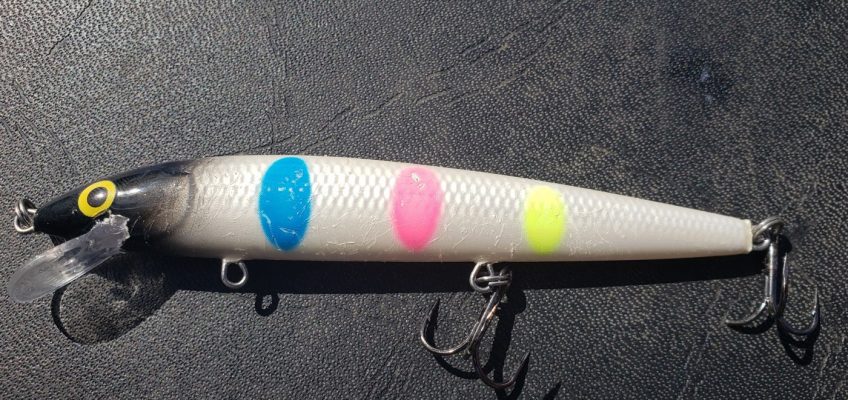Spend enough time fishing, and chances are that you — or someone you know — will have an unpleasant encounter with a fishing lure at some point.
A fish hook in the hand, perhaps, or any number of other places on one’s body.
As the old saying goes, “You’re not a real fisherman until you’ve been caught yourself.”
Been there, done that.
I was reminded of the inevitability of fishing lure unpleasantness last weekend, when a friend and I spent a couple of days trolling crankbaits for pike and walleyes on a certain undisclosed body of water. I’d hoped to entice the fish by jigging, a more relaxing approach to time in a boat, but the fish weren’t having it. Only by covering water using shallow-running lures with multiple treble hooks could we entice the fish into striking.
You can probably guess where this is going by now.
The first time Griffin Blegen used his underwater photo equipment, he captured this image of northern pike and white suckers in the Mississippi River near Bemidji, Minn. in April 2024. Because the water was so cold and he had no wet suit, Blegen improvised by using a PVC pole to submerge the equipment. (Courtesy of Griffin Blegen)
We’d been on the water a couple of hours last Friday afternoon and had already landed a respectable number of pike, along with a couple of bonus walleyes, when my friend and fishing partner reeled in a particularly boisterous pike.
As he tried to free the lure — a No. 12 “Black Wonderbread”-colored Rapala Husky Jerk — the thrashing pike made one of those nasty jerks they’re notorious for making.
Just like that, my friend found himself with a barbed treble hook impaled in the bottom of his left thumb — not the fleshy part on the palm side, fortunately — and the other part of the lure still hooked in the fish.
His options for rectifying the situation were limited.
I know there’s a way to remove an embedded fish hook using a piece of string, but I wasn’t familiar with the technique, and calling up a YouTube video to watch a demonstration didn’t seem like a prudent use of my time at that particular moment.
“I think I’m going to have to go to the ER,” my friend said as the spots of blood dripping from his hand and onto the bottom of the boat grew larger and more prevalent.
The first order of business, I knew, was to free the fish, and fortunately, a set of needlenose pliers was in easy reach. I then unhooked and released the pike as I pondered the options for unhooking my friend.
Another option for removing a fish hook, I’d heard, was to cut the hook and thread the barb through the skin and out a second opening. Using the needlenose, I snipped the hook to remove it from the lure, and sure enough, my friend was able to thread the barb out of his thumb.
The crankbait that hooked both man and fish during a recent fishing excursion. (Brad Dokken / Grand Forks Herald)
Fortunately, this was just a smallish-size crankbait with lightweight hooks. Had it been a big muskie lure with thick treble hooks, a trip to the emergency room may have been the only option.
With the offending hook now removed, the bleeding quickly subsided, and aside from a couple of small puncture wounds (and a crankbait in need of new hooks), the damage was minimal. Instead of a trip to the ER, my friend was back to fishing minutes later. He was ultra careful the rest of the weekend to avoid repeating the mishap and pinched the barbs on the crankbaits he used just to be safe.
Anyone who’s ever handled a thrashing northern pike — even a small one — knows how easily it can happen.
I know I sure can.
Related Articles
‘Sturgeon King’ lives up to his ‘never not fishing’ motto on Rainy River
Minnesota DNR seeks input on special fishing regulation proposals
Hitting a rock brings Manitoba fishing trip to a grinding halt
Just off the top of my head, I can think of at least four encounters with fishing lures, all involving crankbaits and all but one involving thrashing northern pike. On at least two occasions, I’ve had fish hooks embedded in the meaty area at the base of my thumb — if that sounds painful, it is — once in my right leg and, many years ago, a crankbait in my scalp that resulted from a fishing partner’s overenthusiastic cast while I was helping him prefish for a walleye tournament on Devils Lake.
The cap I was wearing saved me from the brunt of that one, and it wasn’t nearly as bad as it could have been. As for the others, I used the “yank and pray” technique while closing my eyes and gritting my teeth to pull the hooks free.
Amazingly, none of my encounters have required trips to the emergency room, either.
My goal is to keep it that way.


Leave a Reply